Sensor Sweep: Celt Mercenaries, Michael Moorcock, Monkey Island
Monday , 10, October 2022 Sensor Sweep 1 CommentHistory (Ancient Origins): Celtic warriors were one of the most important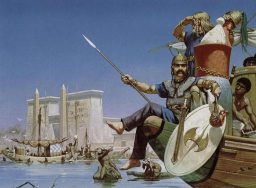 supports of Mediterranean armies. However, it is a little known fact that apart from their role in the Byzantium, these powerful warriors also had a strong connection with ancient Egypt.
supports of Mediterranean armies. However, it is a little known fact that apart from their role in the Byzantium, these powerful warriors also had a strong connection with ancient Egypt.
Firearms (Spec Ops Magazine): 
Browning Hi-Power is a single-action, semi-automatic pistol designed by the legendary John Browning in 1925. It was the last pistol designed by Browning and aimed to meet the requirements of the French military. The pistol is chambered for the 9mm and .40 S&W calibers.
Myths (Irish Central): These fine fellows, ancient Irish monsters and demons, have been terrifying the public since the dawn of Celtic mythology, especially at Halloween. The Irish word for demon is “deamhan” and it is certainly well used because Celtic mythology has always feared an array of evil forces, monsters, demons, and ghosts. The ancient Celts had hundreds of Irish mythical deities, but as with most cultures, they had their demons as well. Some of the Celtic “monsters” were originally gods but were later demonized as pagan creatures when many of the Celts became Christians.
Robert E. Howard (Sprague de Camp Fan): “The Striking of the Gong” was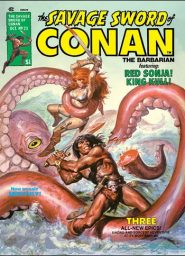 first submitted to Argosy. The current text comes from an untitled typescript. Robert E. Howard refers to the story as “The Chiming of the Gong” in a February 1929 letter to Tevis Clyde Smith but it was listed as “The Striking of the Gong” in the files of Otis Kline, who acted as REH’s agent, and that specific phrase ends the tale. Rejected by Argosy, this story was first published in King Kull, Lancer Books, 1967. It was heavily edited by Lin Carter.
first submitted to Argosy. The current text comes from an untitled typescript. Robert E. Howard refers to the story as “The Chiming of the Gong” in a February 1929 letter to Tevis Clyde Smith but it was listed as “The Striking of the Gong” in the files of Otis Kline, who acted as REH’s agent, and that specific phrase ends the tale. Rejected by Argosy, this story was first published in King Kull, Lancer Books, 1967. It was heavily edited by Lin Carter.
Comic Books (Rageaholic): The American comic industry’s wounds are mortal, and self-inflicted. Now let’s talk about the movement that is out to finish the job!
Cinema (Cinema Blend): In 2016, Warner Bros. Pictures’ brought the Ape Man back to the big screen through The Legend of Tarzan, which stared Alexander Skarsgård, Margot Robbie, Christoph Waltz and Samuel L. Jackson, but it failed to hit with audiences. Now it’s been reported that Sony Pictures is developing its own Tarzan movie, but I can’t help wondering what this means for a potential live-action remake of Disney’s animated Tarzan from 1999.
Gaming (Goodman Games): It is hard to speak of Michael Moorcock’s career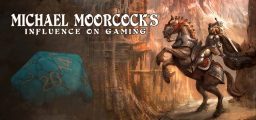 without first acknowledging a great debt owed by the Sword & Sorcery community. It was Michael Moorcock and Fritz Leiber who originally coined the term now used to refer to works such as the Conan stories of Robert E. Howard, and so it is only fitting that “Sword & Sorcery” now encompasses the works of Moorcock himself. This genre of sword wielding heroes confronting the unknown stands as inspiration for a number of role playing game systems (including a particular system which introduces itself with the line “You’re no hero. You’re an adventurer: a reaver, a cutpurse, a heathen-slayer….”). Even before there was an Appendix N to inspire gamers, there was Sword & Sorcery.
without first acknowledging a great debt owed by the Sword & Sorcery community. It was Michael Moorcock and Fritz Leiber who originally coined the term now used to refer to works such as the Conan stories of Robert E. Howard, and so it is only fitting that “Sword & Sorcery” now encompasses the works of Moorcock himself. This genre of sword wielding heroes confronting the unknown stands as inspiration for a number of role playing game systems (including a particular system which introduces itself with the line “You’re no hero. You’re an adventurer: a reaver, a cutpurse, a heathen-slayer….”). Even before there was an Appendix N to inspire gamers, there was Sword & Sorcery.
 Games (Wert Zone): Released back in 1990, The Secret of Monkey Island almost immediately became acclaimed as one of the greatest video games of all time. Fiendish puzzles, funny writing, awful puns and the daftest protagonist name in gaming history combined to make a memorably brilliant, if rather short, game. Monkey Island 2: LeChuck’s Revenge followed a year later with a better story, more interesting puzzles, a much greater variety of locations and fantastic music.
Games (Wert Zone): Released back in 1990, The Secret of Monkey Island almost immediately became acclaimed as one of the greatest video games of all time. Fiendish puzzles, funny writing, awful puns and the daftest protagonist name in gaming history combined to make a memorably brilliant, if rather short, game. Monkey Island 2: LeChuck’s Revenge followed a year later with a better story, more interesting puzzles, a much greater variety of locations and fantastic music.
Art (DMR Books): Yesterday marked one hundred and thirty years since the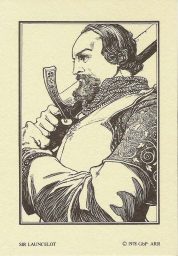 passing of Alfred, Lord Tennyson in 1892. While also known for other poems, like Ulysses and The Charge of the Light Brigade, Tennyson’s name—for me—always brings first to mind his epic Arthurian poetry cycle, Idylls of the King. Even moreso now than usual, when the first chill of autumn is in the air.
passing of Alfred, Lord Tennyson in 1892. While also known for other poems, like Ulysses and The Charge of the Light Brigade, Tennyson’s name—for me—always brings first to mind his epic Arthurian poetry cycle, Idylls of the King. Even moreso now than usual, when the first chill of autumn is in the air.
Science Fiction (Tellers of Weird Tales): If you’re looking for an example of the antipathy that fantasy might have towards science fiction, That Hideous Strength by C.S. Lewis (1945) would be a place to start. One of the basic ideas in this blog is that, being about the past, fantasy and weird fiction (other genres, too) tend towards conservatism. Science fiction is of course about the future and tends to be progressive.
Writing (Silver Key): What is the “fire” borne by characters and otherwise present in the works of Cormac McCarthy and J.R.R. Tolkien? “I am a servant of the Secret Fire, wielder of the Flame of Anor.” – Gandalf, Fellowship of the Ring: “Therefore Ilúvatar gave to their vision Being, and set it amid the Void, and the Secret Fire was sent to burn at the heart of the World; and it was called Eä.” ― The Silmarillion.
Art (Por Por Books): Greg and Tim Hildebrandt were twins, born in Detroit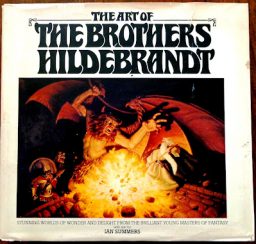 on January 23, 1939 (Tim died of complications from diabetes in June, 2006). They exhibited an artistic disposition and a love for the genres of science fiction and fantasy at an early age.
on January 23, 1939 (Tim died of complications from diabetes in June, 2006). They exhibited an artistic disposition and a love for the genres of science fiction and fantasy at an early age.
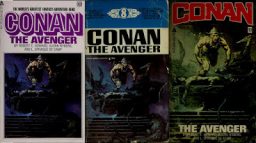 Conan (M Porcius): Conan the Avenger prints two documents; part of Conan creator Robert E. Howard’s 1930s history of Conan’s world, “The Hyborian Age,” and a 1957 novel by Bjorn Nyberg and L. Sprague de Camp, The Return of Conan. So let’s read that 1957 novel; there are three different printings of Conan the Avenger available at the internet archive, so the text from the paperback is not hard to find. (The 1957 hardcover from Gnome Press is a little harder to come by, and goes for over $150 on ebay.)
Conan (M Porcius): Conan the Avenger prints two documents; part of Conan creator Robert E. Howard’s 1930s history of Conan’s world, “The Hyborian Age,” and a 1957 novel by Bjorn Nyberg and L. Sprague de Camp, The Return of Conan. So let’s read that 1957 novel; there are three different printings of Conan the Avenger available at the internet archive, so the text from the paperback is not hard to find. (The 1957 hardcover from Gnome Press is a little harder to come by, and goes for over $150 on ebay.)
Art (DMR Books): When the series debuted with The Coming of the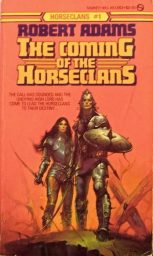 Horseclans in 1975, the cover artist was Carl Lundgren. He also painted the original cover for the follow-up novel, Swords of the Horseclans, in 1977. Both covers were serviceable, but not particularly impressive. However, it appears that the art director at Pinnacle finally wised up and snagged Ken Kelly, who was hot off doing great covers for Lin Carter’s ‘Callisto’ books, the Berkley Conans and two classic covers for KISS. I look at that period here and here.
Horseclans in 1975, the cover artist was Carl Lundgren. He also painted the original cover for the follow-up novel, Swords of the Horseclans, in 1977. Both covers were serviceable, but not particularly impressive. However, it appears that the art director at Pinnacle finally wised up and snagged Ken Kelly, who was hot off doing great covers for Lin Carter’s ‘Callisto’ books, the Berkley Conans and two classic covers for KISS. I look at that period here and here.
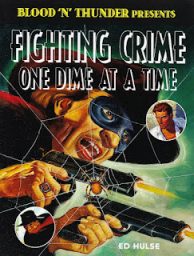 Pulp (Chimney Sweep Reader): Per the Murania Press Website, “In the summer of 2002, long-time friends Ed Hulse, Mark Trost and Rick Scheckman launched Blood ‘n’ Thunder, an amateur journal for aficionados of adventure, mystery, and melodrama in American popular culture of the early 20th century.” As a quarterly publication (with a few gaps), a treasure trove of material has been accumulated over the years. Occasionally, a “Blood ‘N’ Thunder Presents” collection comes along, of which this volume is the third.
Pulp (Chimney Sweep Reader): Per the Murania Press Website, “In the summer of 2002, long-time friends Ed Hulse, Mark Trost and Rick Scheckman launched Blood ‘n’ Thunder, an amateur journal for aficionados of adventure, mystery, and melodrama in American popular culture of the early 20th century.” As a quarterly publication (with a few gaps), a treasure trove of material has been accumulated over the years. Occasionally, a “Blood ‘N’ Thunder Presents” collection comes along, of which this volume is the third.
Pulp (ThePulp.net): I recently obtained a nice, early chapbook from Black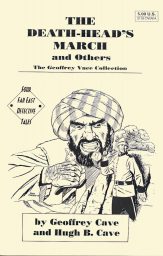 Dog Books: The Death-Head’s March and Others, which is called “The Geoffrey Vace Collection.” t collects four stories Oriental Stories/Magic Carpet, the companion magazine to Weird Tales from 1931-33. Three are by Geoffrey Cave (1906-88) and one by Hugh B. Cave (1910-2004). Thanks to the nice foreward from Hugh, we get a good background on his older brother Geoffrey and his too-brief pulp career — all of four stories.
Dog Books: The Death-Head’s March and Others, which is called “The Geoffrey Vace Collection.” t collects four stories Oriental Stories/Magic Carpet, the companion magazine to Weird Tales from 1931-33. Three are by Geoffrey Cave (1906-88) and one by Hugh B. Cave (1910-2004). Thanks to the nice foreward from Hugh, we get a good background on his older brother Geoffrey and his too-brief pulp career — all of four stories.
D&D (Goodman Games): Like many my age, I was introduced to roleplaying games through the Dungeons & Dragons Basic Set whose rulebook was edited by Dr. J. Eric Holmes. Upon reading it, I was immediately enthralled and soon acquired the Monster Manual, the first of many TSR products that I would seek out over the weeks and months to come.
Science Fiction (Grognardia): Standing alongside the Dumarest of Terra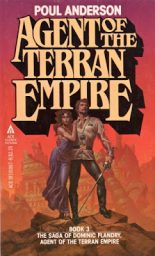 series by E.C. Tubb is the Flandry saga of Poul Anderson, the earliest stories of which first appeared in the 1950s, but were collected and anthologized throughout the ’60s, ’70s, and ’80s. That’s how I first encountered them and I retain an inordinate fondness for the collections published by Ace with covers by the great Michael Whelan, like the one that accompanies this post.
series by E.C. Tubb is the Flandry saga of Poul Anderson, the earliest stories of which first appeared in the 1950s, but were collected and anthologized throughout the ’60s, ’70s, and ’80s. That’s how I first encountered them and I retain an inordinate fondness for the collections published by Ace with covers by the great Michael Whelan, like the one that accompanies this post.
 Cinema (Iron Age Media): In Escape From Planet Omega-12, a young woman is marooned on a primordial alien world filled with hostile alien life. With only a few weapons, a small floating robot, and the aid of a strange entity that has absorbed the personality of her dead husband, she must remain on the move to avoid capture from a mysterious hidden enemy. Created in the tradition of stories like Fire & Ice, Heavy Metal, and Samurai Jack, combining practical effects miniatures and puppets with traditional animation, Omega-12 aims to infuse science fiction and the pop-culture entertainment landscape at large with new energy in the hopes to deliver what Hollywood refuses to.
Cinema (Iron Age Media): In Escape From Planet Omega-12, a young woman is marooned on a primordial alien world filled with hostile alien life. With only a few weapons, a small floating robot, and the aid of a strange entity that has absorbed the personality of her dead husband, she must remain on the move to avoid capture from a mysterious hidden enemy. Created in the tradition of stories like Fire & Ice, Heavy Metal, and Samurai Jack, combining practical effects miniatures and puppets with traditional animation, Omega-12 aims to infuse science fiction and the pop-culture entertainment landscape at large with new energy in the hopes to deliver what Hollywood refuses to.
Westerns (Rough Edges): I still consider Luke Short an excellent Western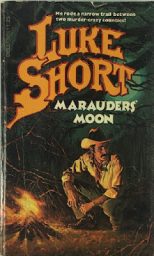 author, however, and still read one of his books from time to time. A lot of his novels are available as e-books, and that’s how I recently read MARAUDERS’ MOON. (The cover above is the Dell edition I owned but never got around to reading.)
author, however, and still read one of his books from time to time. A lot of his novels are available as e-books, and that’s how I recently read MARAUDERS’ MOON. (The cover above is the Dell edition I owned but never got around to reading.)
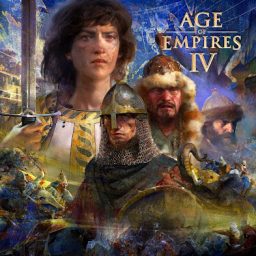 Games (Wert Zone): The venerable real-time strategy series is back. A year ago, after a sixteen-year gap, Microsoft released Age of Empires IV, the latest in one of the most beloved strategy series of all time. It has a very strong heritage to live up to, so the question is if it has succeeded, especially with new franchise developers Relic coming on board. Relic have a solid pedigree, but their last game was the very underwhelming Warhammer 40,000: Dawn of War III, so a lot was riding on this game for them as well.
Games (Wert Zone): The venerable real-time strategy series is back. A year ago, after a sixteen-year gap, Microsoft released Age of Empires IV, the latest in one of the most beloved strategy series of all time. It has a very strong heritage to live up to, so the question is if it has succeeded, especially with new franchise developers Relic coming on board. Relic have a solid pedigree, but their last game was the very underwhelming Warhammer 40,000: Dawn of War III, so a lot was riding on this game for them as well.
Actors (LA Times): Hollywood loves few things more than retailing myths and legends about itself. Few of these yarns have had a longer life than what happened at the 1973 Academy Awards involving Marlon Brando, John Wayne and a Native American activist named Sacheen Littlefeather.
Cinema (Frontier Partisans): Since that September day in 1992, I’ve watched all or parts of The Last of the Mohicans times beyond count. I have probably listened to Dougie MacLean’s The Gael theme every day since.
watched all or parts of The Last of the Mohicans times beyond count. I have probably listened to Dougie MacLean’s The Gael theme every day since.
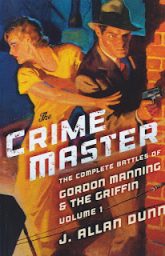 Pulp (Chimney Sweep Reader): Continuing my tour of story collections from the pulp era, I turned this time to The “Crime Master” otherwise known as the continuing battles of Gordon Manning & The Griffin. The stories in this collection were originally published from 1929 through 1931 in “Detective Fiction Weekly” magazine and are presented in chronological order.
Pulp (Chimney Sweep Reader): Continuing my tour of story collections from the pulp era, I turned this time to The “Crime Master” otherwise known as the continuing battles of Gordon Manning & The Griffin. The stories in this collection were originally published from 1929 through 1931 in “Detective Fiction Weekly” magazine and are presented in chronological order.
History (Isegoria): How long has it been since you’ve thought about Robin Hood?, Alexander Palacio asks: He’s not around as much as he used to be; an odd absence for him and the venerable set of characters and stories that orbit him. Robin and his Merry Men seem underrepresented in modern media. The few big Robin Hood films made recently have flopped.
Lovecraft (Noah Pinion): I’m going to ask the entertaining and silly question: Is AI an incomprehensible cosmic horror out of the pages of an H.P. Lovecraft story?
For those of you who are unfamiliar with H.P. Lovecraft, he was a horror fantasy writer who lived in New England a century ago. His stories often center around humans encountering various incomprehensible monsters and super-beings from outer space or other dimensions, and generally going insane as a result.
Fantasy (Tim S Brannon): This adventure has a solid pedigree. It is based on Ian Livingstone’s Fighting Fantasy books from 1984. This adventure is for the d20 system / D&D 3.0 system published in 2003. So nearly 20 apart, here I am nearly 20 years after that reviewing it.
on Ian Livingstone’s Fighting Fantasy books from 1984. This adventure is for the d20 system / D&D 3.0 system published in 2003. So nearly 20 apart, here I am nearly 20 years after that reviewing it.
This adventure covers the same plot and situations from the Fighting Fantasy “choose your own adventure” book.
One of your best roundups. I think I went to almost every site.